
Model_UN_English
.pdf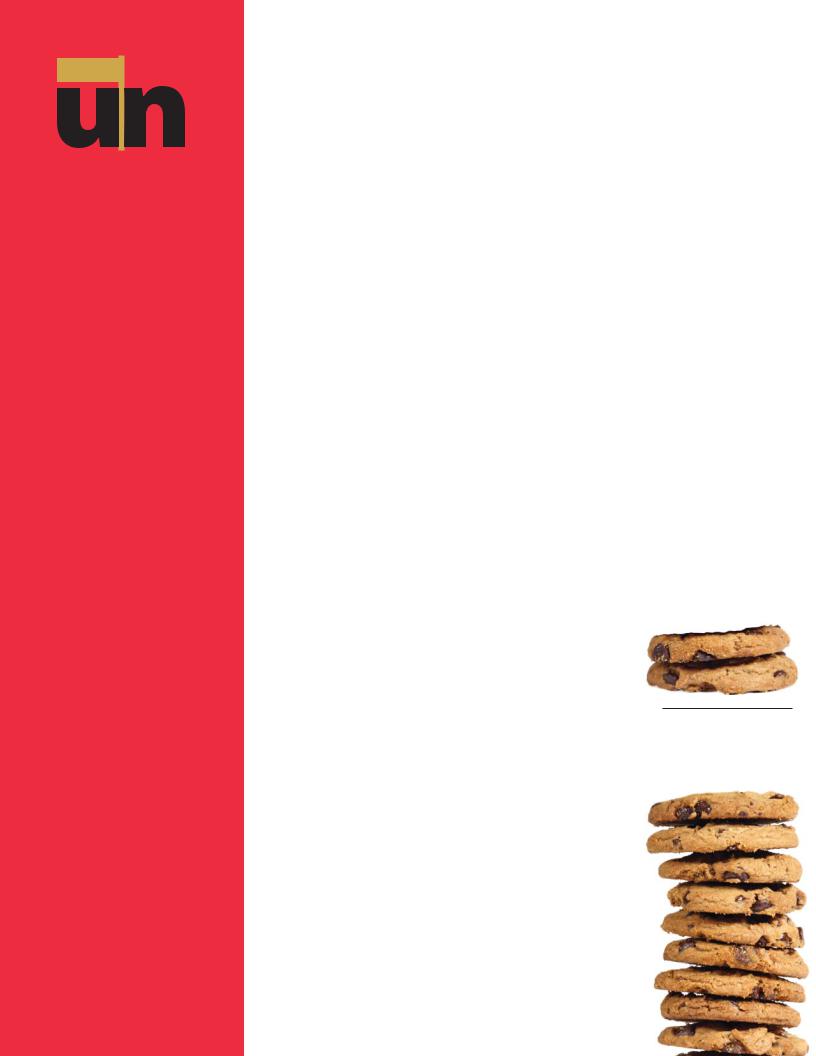
model
THRIVES
IN
argentina
By Anastasya Lloyd-
Damnjanovic
Shutterstock ©
From containing a global epidemic to
mediating border disputes, hundreds
of young Argentineans are tackling thorny international
problems as participants in the Buenos Aires Model UN. And though
their mediations may be pretend, the issues they debate are very real.
In Model UN, secondaryand college-age students step into the shoes of UN delegates. Acting as diplomats from UN member countries, participants research issues and formulate negotiating positions based on the real interests of the countries they represent. Participants who represent the United States sometimes find their roles particularly challenging, as the United States is involved in nearly every issue that comes before the international body and is a member of the UN Security Council.
“It amazed me the number of responsibilities all over the world the [United States] has at the same time,” said 19-year-old Model UN delegate Lucas Fernández.
Fortunately, young delegates representing the United States in Argen tina have a reliable resource to guide them: the diplomats
at the U.S. Embassy in Buenos Aires.
Embassy Engagement
After several Argentine Model UN delegates reached out to learn more about U.S. foreign policy, the U.S. Embassy in Buenos Aires decided to develop a program to help Model UN delegates represent the United States. In 1997, the U.S. Embassy partnered with nongovernmental organization Asociación Conciencia (Spanish for “Awareness Association”) to connect with local Model UN groups.
Fifteen years later, the embassy’s Model UN program is still going strong. Each year, more than 350 students from 60 schools across Argentina visit the embassy or at
tend digital sessions to prepare for Model UN conferences.
Students come from schools both near and far, public and private, with ages ranging from 14 to 20 years.
All-American treat: Freshbaked chocolate chip cookies keep Model UN delegates energized at the U.S. Embassy in Argentina.
©Shutterstock eJournal USA | 9

Visit the U.S. Embassy in Argentina’s website! http://goo.gl/fUbRg
Though Asociación Conciencia helps get the word out about the embassy’s program, many groups learn of it from past participants. “I was surprised by the support we received [from the U.S. Embassy] and the willingness to help us find information,” said 19-year-old program alumna Gimena Ayala.
A Day in the Life of
a Diplomat
Most Model UN preparation sessions at the U.S. Embassy last a full day. Students are invited to the embassy’s Information Resource Center (IRC), where they have access to thousands of publications and other materials on U.S. foreign policy — and to embassy staff and diplomats.
The IRC’s Model UN liaison greets them upon arrival and IRC staff lead students in discussions of issues that their upcoming Model UN conferences will
address.Topics range from nuclear disarmament and financial crises to climate change and humanitarian aid. The goal is not to simply tell Model UN delegates how to represent U.S. foreign policy, but to teach them how to research, analyze and develop foreign policy on their own. Political and economic officers at the embassy sometimes brief students on real issues they are working on, and even the U.S. ambassador has been known to join in.
“The approach is to help them locate and evaluate information, distinguish opinion from policy through comparison of different information sources, identify appropriate official sources and analyze specific documents to find policy positions,” IRC Coordinator Graciela Spedalieri explains.
But the program isn’t all work. Delegates also get a taste of daily life at the embassy, chatting with staff over lunch in the
embassy cafeteria and socializing with their fellow Model UN participants.
“I had the pleasure of meeting lots of people trying to improve their knowledge,” said participant Florencia Antonella Mastroianni. “We all had one point in common: trying to help and find solutions for major global problems.”
And of course, no visit to a U.S. Embassy would be complete without a truly American treat. Chocolate chip cookies prepared by the embassy chef are on hand all day to fortify the delegates during their actionpacked agenda.
Role-Playing
Leads to Real
Understanding
Delegates leave the embassy better prepared for their roles as U.S. delegates in Model UN conferences, but the program’s
eJournal USA | 10
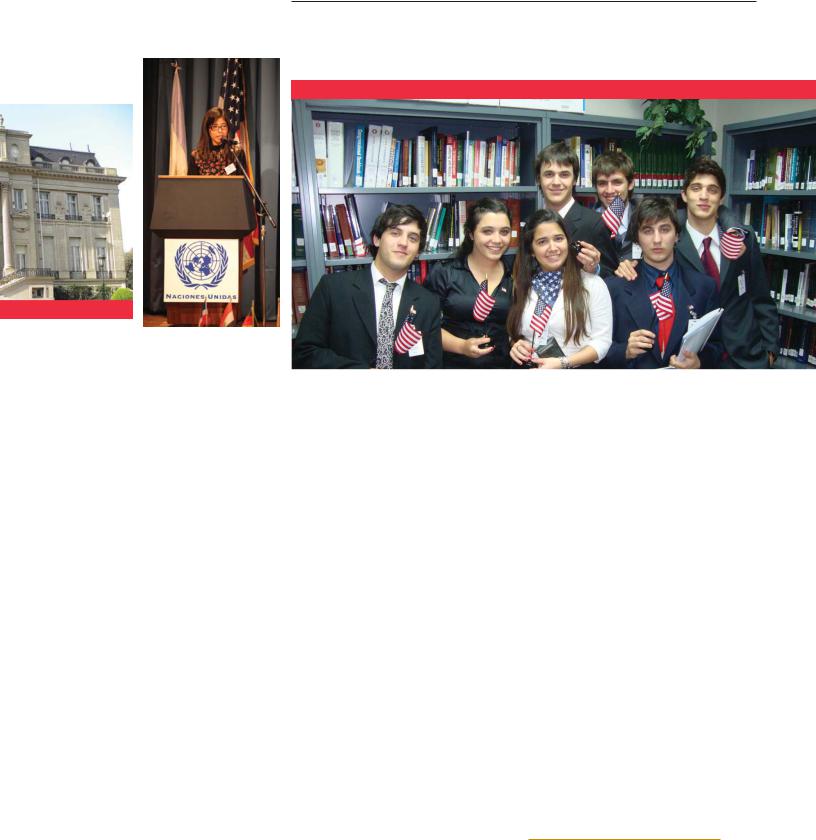
Left to right: U.S. Ambassador to Argentina Vilma Martinez meets with local university students preparing for Model UN at the U.S. Embassy in Buenos Aires. | Participant Jonatán Carné | The U.S. Embassy building in Buenos Aires | A student attending the U.S. Embassy in Buenos Aires Model UN conference in 2011 | Argentine students gear up to represent the United States at a Model UN conference by visiting the Information Resource Center at the U.S. Embassy in Buenos Aires.
impact extends beyond the conference room.
Adopting the perspectives of other countries not only leads Model UN participants to develop a more complex understanding of the world, but also of the United States’ place within it.
“Before getting involved with the simulations, I thought of the United States as an alienated nation which only cared about its own profit,” said 18-year-old Alejandro de Cousandier. “However, I realized my thoughts were not exactly correct. I’ve learned to see the world from a more complex point of view, where decisions are not to be taken easily, but have to be reached by consensus — to be argued over or even to be subject to voting.”
According to Jonatán Carné, 20, the embassy program also exposes participants to the considerations behind U.S. foreign policy
decisions. “I can see, after the program, that decisions are made within a context, a national reality,” he said, alluding to the domestic pressures that foreign policymakers often feel. “I have changed my point of view and it has helped me to understand lots of decisions and events from the United States’ or other countries’ perspectives without prejudging.”
Agents of Change
For many participants, Model UN is not just an after-school activity, but the beginning of a lifetime devoted to diplomacy and international affairs. The experience of working together to solve global challenges opens their eyes to the power of the international community to help people.
For Mastroianni, the experience changed the way she sees the world and its problems. “Before participating in this program, my view of the world was very
Photos: U.S. Embassy in Buenos Aires
simplistic. I refused to understand some situations. But now I can analyze them through a different perspective.”
As a result of her participation in the U.S. Embassy’s Model UN program, the 19-year-old is now pursuing a bachelor’s degree in government and international relations.
Carné, now studying international relations at the National University of Rosario, says Model UN directly contributed to his decision to pursue a career in international affairs. “I saw that the international system is a place to work on key problems that can change negative situations and consolidate agents of change,” he said. “I want to make the world a place of understanding.” 
Anastasya Lloyd-Damnjanovic is an intern with the U.S. Department of State’s Bureau of International Information Programs.
eJournal USA | 11
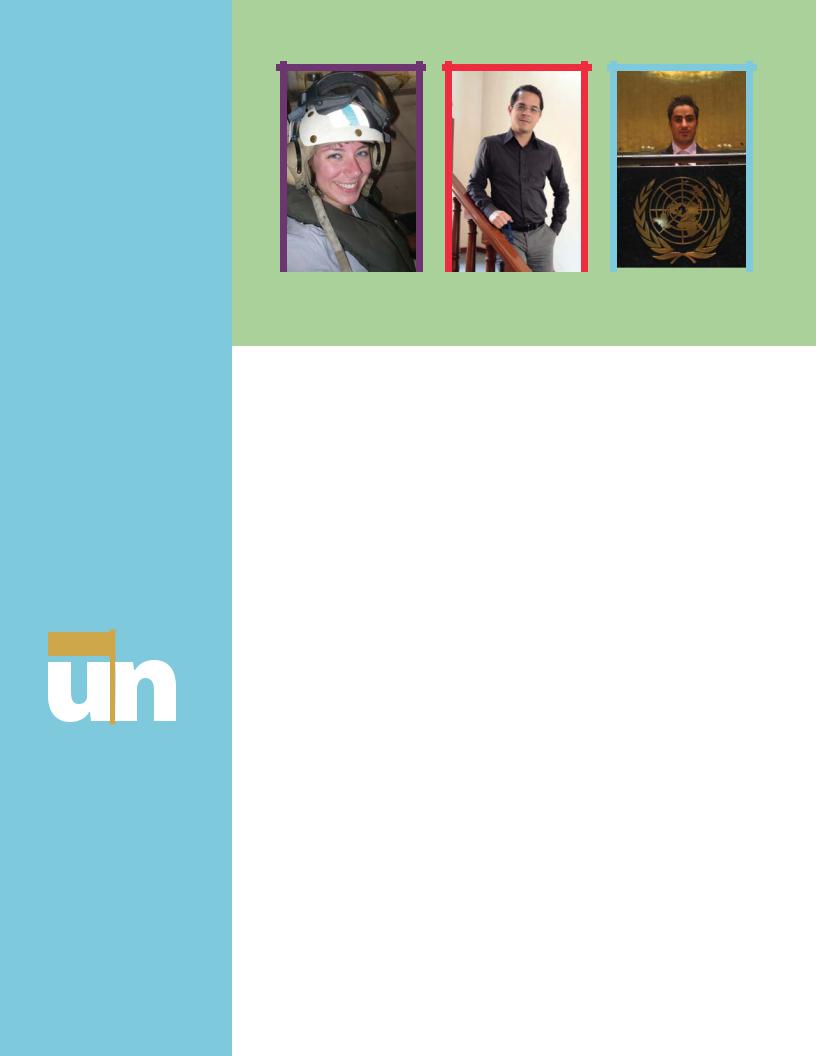
WHERE
ARE
THEY
today?
model
Alumni in
International
Relations
By Ashley Rainey Donahey
photos Courtesy
BETH |
|
ADRIAN |
|
SOUSHIANT |
MILTON |
|
RODRIGUEZ- |
|
ZANGANEHPOUR |
|
|
MONTFORT |
|
|
Many Model UN
participants choose
to pursue careers
in international
affairs. Follow the
stories of three people
who have parlayed their
passion for Model UN into
professional success.
eJournal USA | 12

BETH MILTON: FROM ROLE-PLAY TO ROLE MODEL
When Beth Milton was first introduced to Model UN at age 13, her expectations
were not high. She joined her middle school’s Model UN club because her best friend said it might be fun. She never dreamed that her new afterschool activity could change her life.
“Going into Model UN, I knew the big countries in the world,” Milton said, “but I learned that there are so many more countries out there, each with their own perspectives and governments.”
Milton continued doing Model UN throughout secondary school and into college. By the time she finished her university studies, the career path she would pursue was clear: She would work in international affairs.
Milton, 28, is now a U.S. Foreign Service officer working in the U.S. Embassy in Tel Aviv, Israel.
“Model UN directly led to my interest in foreign affairs,” Milton said,“which led to me eventually joining the U.S. Foreign Service and becoming a diplomat.”
Real World Skills
Fortunately the skills Milton developed in Model UN proved as useful in her professional life as they did in the conference room. Working together with delegates from around
photo Courtesy
the world made her a more effective negotiator, she says. Participating in Model UN gave her “a much more global perspective on things,” she says. “It taught me how to collaborate in negotiations with people from different countries and different objectives.”
Serving as a Model UN delegate also improved Milton’s publicspeaking ability, a useful skill in any profession.
“A large part of Model UN is you just need to get up there and talk,” she explained. “That’s something that I’ve carried with me throughout school and my career: being able to get in front of a bunch of people with no notes and start going.”
Bonding Experience
Model UN not only impacted Milton’s professional choices, but her social life too. As her interest in international affairs grew, so did her circle of friends. “We would hang out at Model UN Club, then at lunch and after school. It’s a very good way to make friends,” she said.
Traveling for multiple Model UN conferences in her home state of Virginia as well as one in Canada only deepened those friendships. In fact, she remains in touch with those friends despite the distance imposed by her diplomatic position.
American diplomat: Beth Milton is a U.S. Foreign Service officer currently serving at the U.S. Embassy in Tel Aviv.
“We really bonded,” she said. “I made really, really good friends. [Model UN] became my social circle.”
A Tool for Peace
Milton hopes more young people will get involved with Model UN. For her, Model UN is much more than a great way to make friends. In the U.S. Embassy in Tel Aviv where she works,Milton sees Model UN as a tool for peace.
“We use it in Israel,” she explains. “We’ll have Palestinian kids pretend they are Israeli and the Israeli kids pretend they are Palestinian, and suddenly they understand the other side’s points and arguments.”
“If you can understand
— even if you don’t accept — what another country’s policies are, you can understand where they are coming from.”
eJournal USA | 13

ADRIAN RODRIGUEZ-MONTFORT: PASSIONATE ABOUT POLITICS
Acting the part: U.K. diplomat Adrian Rodriguez-Montfort says Model UN helped him learn how to “act” effectively on the world stage.
photo Courtesy
placard — El Salvador — signaling his intention to give a speech.
“I just thought I’d be 10, 20, 30 odd [names] down on the list,” he said. “And I was the first one called, so you can imagine my shock.”
He furiously studied his notes and reviewed the rules of procedure before moving to the dais to address hundreds of fellow delegates. He managed to deliver a short speech representing El Salvador’s position on nuclear nonproliferation and returned to his seat without a hitch. But it was what happened afterward that he said got him hooked.
For Adrian RodriguezMontfort, participating in his first Model United Nations (Model UN) conference was a case of love
at first speech. As he entered the conference hall of Harvard’s Model UN conference in Cambridge for the first time in 2001, the initial call for speakers rang out. RodriguezMontfort raised his country’s
“A flurry of messages from representatives from all over the world came in, saying: ‘Yes, let’s get together. Let’s start planning. I’ve got some ideas.’ And I was just absolutely taken by the speed of it — the actual feel of the negotiation and cooperation,” he said. “No matter how small the country that you’re representing may be, you can still have a major
role. You can actually influence a much larger debate.”
Although he was already in college at the time, RodriguezMontfort pursued Model UN with a passion. “I just fell absolutely in love with it,” he said. “From there it was just a rampage of conference after conference trying to make the most of it out of the short time.”
Making the Most of
Model UN
Although his days as a Model UN delegate have long since passed, Rodriguez-Montfort, 28, stays connected with the program. During his senior year in college, he staffed numerous conferences, collaborating alongside the U.S. United Nations Association’s
Global Classrooms Program in Houston, Los Angeles and New York, and even served as a committee director, deputy secretarygeneral and secretary-general for United Nations simulations.
model |
HALL OF FAME |
|
|
|
Ban Ki-moon |
|
UN secretary-general |
Many Model UN participants have become
leaders in diplomacy, politics, law
and media. See if you recognize any of these high-flying former Model UN delegates!
eJournal USA | 14
Images AP ©
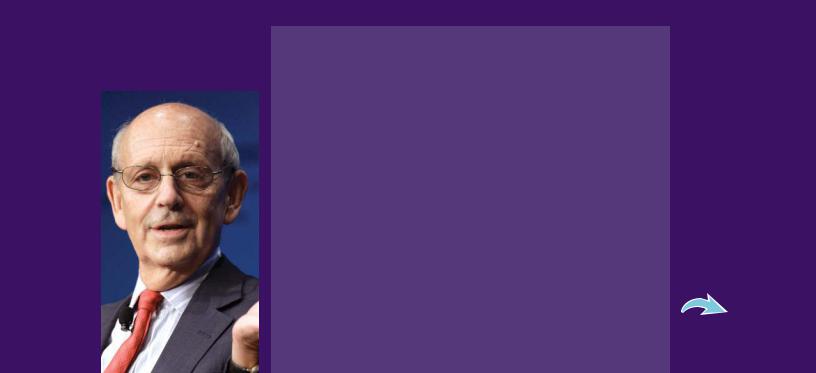
Now Rodriguez-Montfort gets his international cooperation and negotiation fix through his position as senior policy adviser for climate change and energy policy for the United Kingdom’s Foreign Office at the British Embassy in Mexico City. He landed his position, he said, in large part thanks to his Model UN experience and connections.
“You meet people in the conferences, who then go on to do internships, who then recommend you for internships, and that internship gives you a position, and that position takes you somewhere else,” he explained.“The Model UN circuit becomes sort of a closeknit family.”
Model UN offers more than just an extensive social network, however. Rodriguez-Montfort credits his finely honed negotiation and public-speaking skills to the many hours he spent practicing in conferences. While these skills can be taught in a classroom, they are best developed by doing.
“Conference after conference, you have the chance to test [your skills] in a safe, controlled environment,” he said. “Years after that, when you’re actually in the international arena and you’re actually in negotiations, it feels very much natural. You’ve done it a hundred times before in Model UN.”
Acting on the international stage feels so natural, in fact, that Rodriguez-Montfort says his first reaction when entering real international summits and conferences is: “Oh, it feels like Model UN all over again.”
Lasting Impressions
Although Rodriguez-Montfort believes that Model UN is a natural step for anyone interested in international affairs, he is quick to point out that students of any background or interest can benefit. “You don’t have to be somebody that wants to pursue a career in international affairs, politics or policy. It’s a learning experience that gives you a lot of tools and experiences that will be beneficial to you no matter what career you choose in the future.”
Another lesson Model UN teaches is humility. “You can’t think you’re the end-all, be-all when you’re in Model UN. You realize you’re just a small part of a bigger system that makes you feel that you’re a part of something much bigger than yourself,” he said. “It will really shape how you view yourself and how you view yourself in the world.”
Grateful for all that Model UN has helped him accomplish, Rodriguez-Montfort hopes that more young people can be as fortunate as he has. “I cannot conceive of myself reaching this relatively senior position by my age if I had not taken on that challenge. It has shaped me in more ways than one, and I would really wish that other people will have the chance to have that same experience.”
His advice to any young people considering participating in Model UN: “Just do it! The experience is fantastic!”
Justice Stephen Breyer
U.S. Supreme Court
“When I was an undergraduate at Stanford, I was twice a delegate to the Model United Nations and once a member of the Secretariat (when Stanford was the host). Students are enthusiastic role-players. We had to learn how nations and their representatives could work with others. We learned about how the United Nations (and international relations) worked in practice. The experience was valuable; the conferences were educational; and it was great fun. I am delighted to learn more than half a century later the Model UN is still going strong. I should think that in today’s great global conversation it offers … students an even more valuable experience.”
Images AP ©
eJournal USA | 15

Soushiant Zanganehpour, 29, says participating in Model UN helped him figure out what he wanted to do when he grew up.
SOUSHIANT ZANGANEHPOUR:
MAKING IT WORK
photo Courtesy
When deciding what you want to be when you grow up, knowing what you do not want to be can be as valuable as knowing what you want. In the case of Soushiant Zanganehpour, participating in Model United Nations (Model UN) helped him figure that out.
Zanganehpour, 29, is the head of strategy and operations at the University of Oxford’s Skoll Centre for Social Entrepreneurship, an academic organization that encourages innovative social transformation. He has held numerous positions in the private and nonprofit sectors, working on such issues as disarmament, nonproliferation of nuclear technologies, and corporate social and environmental responsibility.
But as a university student, Zanganehpour — like many students — was not sure what sort of career he wanted to pursue. “For me [Model UN] was a phase of trial and error, and figuring out whether the area of diplomacy and public affairs is really for me or not,” Zanganehpour said.
Through Model UN, Zanganehpour came to realize that the issues he was most passionate about could also be explored outside of government.
model UN HALL OF FAME
Judge Stephen M.
Schwebel
Former judge and president of the International Court of Justice
Archive Scholars Eminent Library Squire / Cambridge of University Bates/ Daniel ©
Rainn Wilson
Actor and comedian, best |
Ryan Seacrest |
|
|
known for his role as |
American television person- |
“Dwight” on the American |
ality, best known as host of |
television series The Office |
American Idol |
Images AP © |
Images AP © |

Learning the Basics
At first, he found the experience to be a bit overwhelming. “It was like being thrown into the deep end, learning lingo and the decorum, and the limitations of the different fora and what they can and cannot do,” he said. But eventually he got the hang of it, made friends and even mentored other Model UN groups.
Zanganehpour, who grew up first in Iran and then Canada, also got to travel to the United States, Scotland and China as a participant in Model UN. He says it helped him understand the basics of international affairs. “Model UN provided a primer — first of all of understanding national interests and regional bloc interests — and the basics of countries and of international affairs.”
After he had learned about other countries’ languages, currencies, demographics, geographies, politics and histories, he found himself wanting to learn more. Through Model UN, Zanganehpour came to realize that the issues he was most passionate about could also be explored outside of government. “I would like to have a very different kind of impact,” he said. “I needed to do a deeper dive into the different issues.”
Model UN conferences taught him how to prepare for public speaking, he said. In addition, learning how to get to the root of an issue and be able to articulate that issue to someone else — as delegates must do during negotiations — is a skill that Zanganehpour argues is valuable in any job.
Zanganehpour points out that there’s another, oftenoverlooked capacity that Model UN fosters: empathy. In his current job, Zanganehpour works with many different foundations and social entrepreneurs, and he says that without the ability to put himself in the shoes of others, he wouldn’t be able to do his job. It is through the development of so-called “people skills”
— the ability to build and maintain relationships, manage competing interests and garner support for your ideas — that Model UN really translates into professional success, he said.
“Those are really, really important skills in life, and the simulation of Model UN will put you in a context where you have to find consensus amongst people that have very different interests.”
Zanganehpour encourages young people to give Model UN a try and see what it’s all about, but to not get discouraged if they find it’s not the kind of
Finding a New Path
Despite the variety of professional positions he has held, however, Zanganehpour says he uses the skills he developed in Model UN “every day.” Above all, he values the communication experience he gained. Having to speak before hundreds of his peers at
work they want to do. “If you don’t find
the impact you’re looking for in [Model UN], go and try entrepreneurial things. Go and try to make change happen.” 
Kiyotaka Akasaka |
George |
Samuel L. |
|
Stephanopoulos |
Jackson |
||
Former UN under-secretary- |
|||
general for communications |
Television journalist and former |
Television and film |
|
and public information |
adviser to President Bill Clinton |
actor, producer |
Images AP © |
Images AP © |
Images AP © |
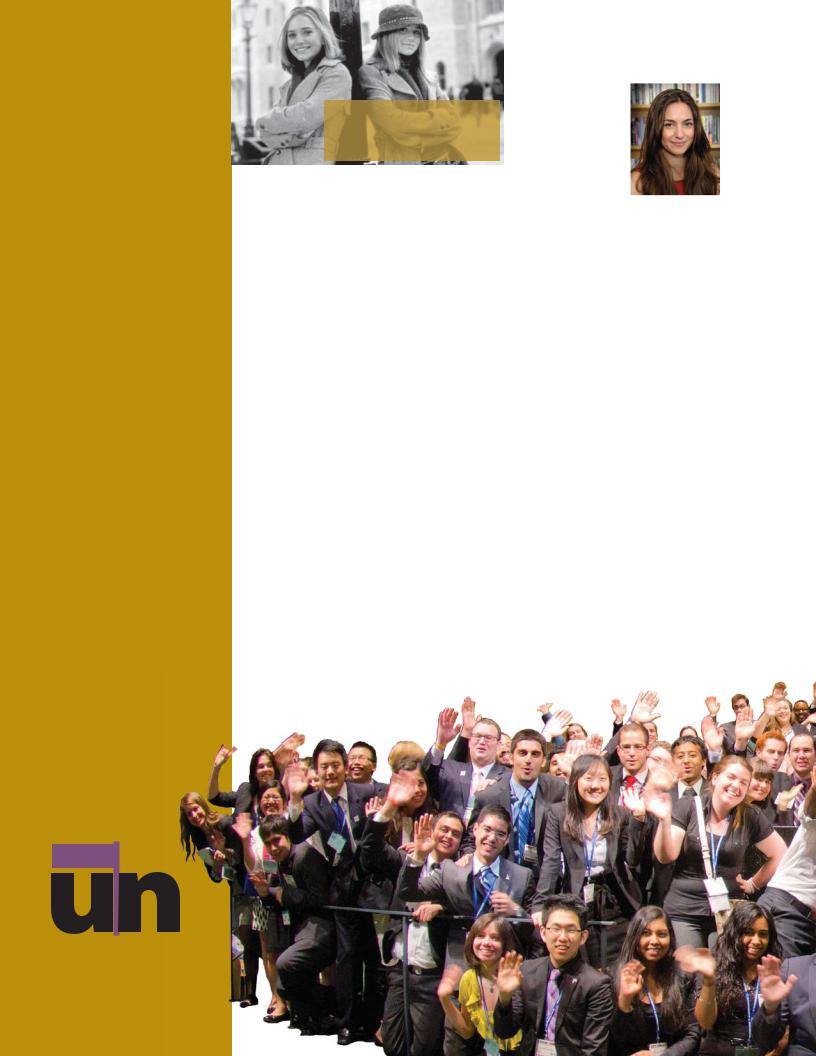
HOW
TO participate
in
model
By Ana Ramic
eJournal USA | 18
|
Video/ Home Warner © |
|
|
After-school inspiration: Ana Ramic de- |
Courtesy |
|
|
|
|
||
cided to start her own Model UN club |
CollectionEverett |
PhotographyHackettJoan |
|
after watching the film Winning London, |
|||
|
|
||
starring Mary-Kate and Ashley Olsen. |
|
|
Originally from Bosnia,Ana Ramic, 26, lives in Chicago, where she is a program coordinator for the Chicago Council on GlobalAffairs.
She has previously worked for the British Consulate in Chicago, the U.S. Embassy inAthens, Greece, and the National Democratic Institute inWashington and Sarajevo, Bosnia.
The first time I heard of Model
United Nations, I was 15 years old and
watching a movie called Winning London.
The film was about a very driven girl named Chloe who was the leader of her secondary school’s Model UN team. After performing particularly well in a local competition, Chloe and her team are selected to attend an international Model UN competition in London. Drama, adventure and hilarity ensue, and naturally the team returns home victorious.
After watching the movie, I was thrilled to learn that Model UN actually exists — and not just in Hollywood. I found out that there is a real organization where kids my age could hold real debates, on real issues, while representing real countries. Not only that, but with Model UN, you could travel to international conferences and meet kids from all over the world!
I immediately set to learning as much as I could about Model UN and how I could get involved. After calling all the schools in my area, I learned that there were no local Model UN clubs … yet.
So, I started one on my own — and so can you.
